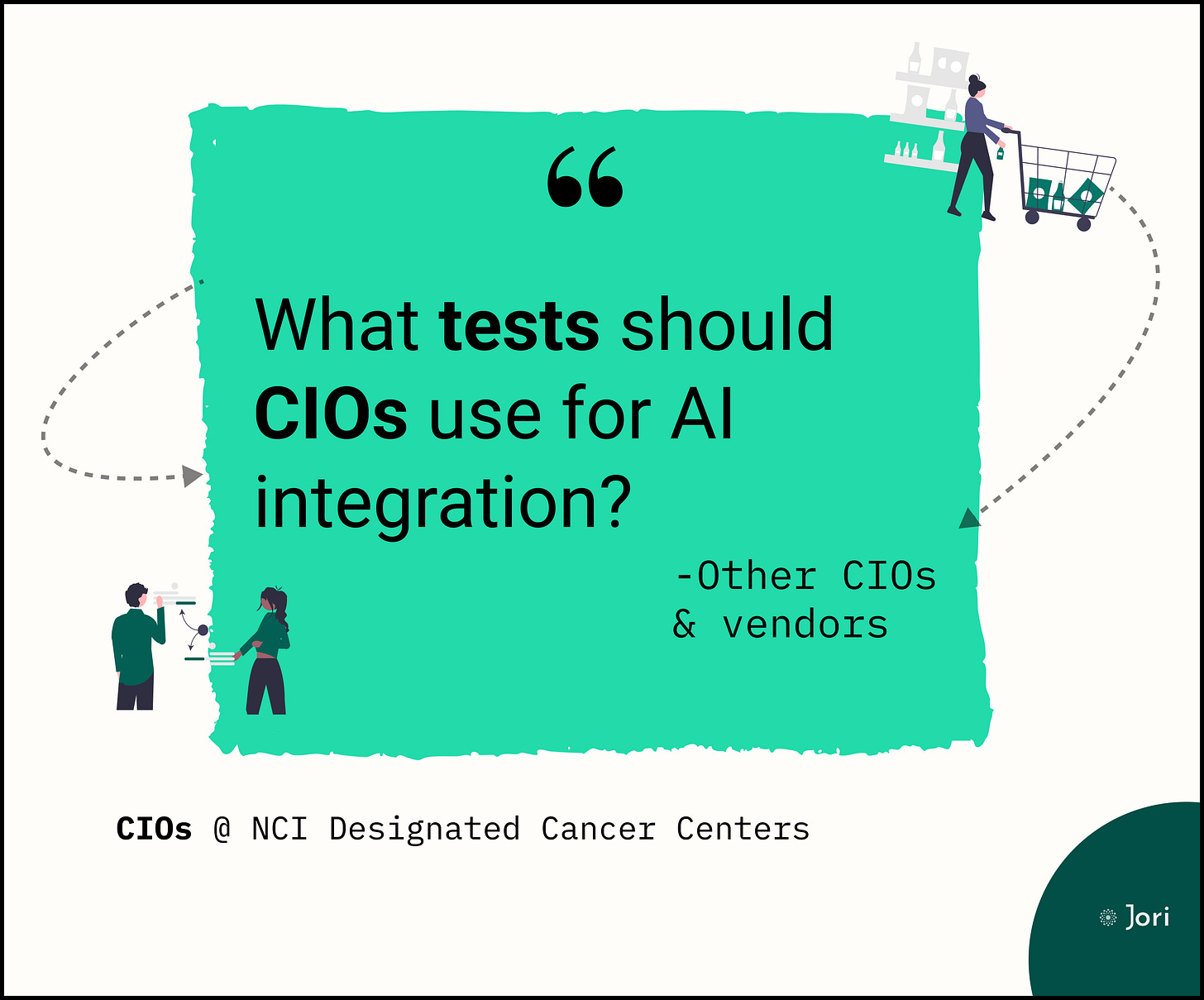How to Evaluate AI Agents for Clinical Integration (at scale): Some Field Notes
A framework for CIOs navigating the signal-from-noise in clinical agentic AI
Agents are coming. But who do you let in, and how do you decide?
💡 Every seasoned CIO knows: technology integration is easier than change management.
But nobody talks about integration, or how to integrate agentic AI at NCI Designated Cancer Centers.
The Integration Paradox You're Already Living
Software solutions in the onco space tackle management productivity, not operational productivity.
This is what its looking like right now:
oncologists are drowning in tools that promised to help them.
Epic notifications pile up.
Trial matching systems sit unused.
Quality dashboards gather dust while care coordinators manually chase down the same data points they could pull automatically.
💡 Insight: AI tools that add more workflows fail. AI agents that disappear into existing workflows transform care.
Most vendors want to add more cockpit buttons. What you need is better air traffic control.
Think of your cancer center as an airport. Patients are planes seeking safe landing. Oncologists are pilots making split-second decisions with incomplete information. Your clinical workflows are air traffic control: coordinating complex, time-sensitive operations where delays cost lives.
The Three Tests of True Clinical Integration
Before evaluating any AI agent, apply this framework:
1. The Invisible Integration Test
Question: "Where does this require my staff to go?"
If the answer involves logging into a new portal, opening a separate application, or "just checking one more dashboard," walk away. True integration means the AI works within your existing EMR, PACS, and clinical decision tools.
Red flag: Vendors who lead with their UI instead of their API documentation.
Green flag: Agents that auto-populate fields in Epic, pre-draft tumor board summaries in your existing templates, or queue up trial matches directly in your workflow tools.
2. The Cognitive Load Test
Question: "Does this reduce or increase the mental burden on my clinicians?"
Effective AI agents don't just provide information, they provide actionable information at the precise moment it's needed. They eliminate the cognitive overhead of remembering to check multiple systems, cross-reference guidelines, or manually format reports.
Real example: Instead of alerting oncologists about potential trial matches, the agent pre-drafts enrollment correspondence with eligibility rationale already documented, ready for physician review and one-click sending.
3. The Outcome Alignment Test
Question: "How does the vendor make money when this succeeds?"
Vendors who truly believe in integration will tie their revenue to clinical outcomes—faster time to treatment, increased trial enrollment, reduced documentation burden. If they're selling seats or charging for API calls, their incentives aren't aligned with your operational goals.
The litmus test: Ask about risk-sharing arrangements. Vendors confident in their integration will discuss shared savings models.
What Real Integration Looks Like in Practice
Before AI Agent:
Tumor board prep takes 45 minutes per case
Trial screening happens when someone remembers
Quality reporting requires manual chart review
Prior authorizations delay treatment starts
After AI Agent (done right):
Tumor board packets auto-generate with treatment options ranked by evidence strength
Trial matches appear in the treatment planning interface with eligibility pre-checked
Quality metrics update in real-time as care is documented
Prior auth requests submit automatically with supporting evidence attached
The key insight: Oncologists shouldn't know the AI is there. They should just notice that everything works better.
The Implementation Reality Check
Even the best AI agents fail without proper change management. The technology integration is the easy part. The hard part is ensuring your teams trust, adopt, and optimize around the new capabilities.
Three critical success factors:
Champion identification: Find the oncologists who are already workflow optimizers, not just tech enthusiasts
Incremental deployment: Start with one use case, prove value, then expand
Feedback loops: Measure both clinical outcomes and user satisfaction—they must improve together
The Bottom Line for CIOs
AI agents represent the first generation of clinical AI that can truly scale precision medicine. But only if you choose partners who understand that the best technology disappears into the background.
💡Your procurement question shouldn't be "What can this AI do?" It should be "How will my oncologists' day change when this is working perfectly?"
If the vendor can't answer that question with specific, measurable workflow improvements, keep looking. The future of cancer care depends on getting this integration right.
About US:
Jori is the agentic operating system for precision oncology.
Send us a note: hello@jori.health

